I’m going to report now on some research that I completed just over a year ago. I was doing this study on Ted Williams and umpires.
If you focus on it, there are a lot of stories about Ted Williams and umpires. There is, of course, the oft-repeated canard that, over the second half of his career, Ted Williams was allowed to define his own strike zone. This is usually told in something like the following form. A young pitcher is struggling to find the strike zone, and he throws a couple of close pitches to Ted Williams, who takes them both and is ahead in the count 3-1. "Where was that?" yells the injured pitcher.
"Young man," replies the umpire, "Mr. Williams will let you know when you have thrown a strike."
It would high praise for this story to suggest that is apocryphal; an "apocryphal" story, after all, could be true. But if you think about this story and assume that it is true, you realize that it does not necessarily assume that the umpire is favoring Ted Williams. The umpire could be merely expressing respect for Williams. He could be saying to the young pitcher that "as soon as you put one in the strike zone, Williams is going to crush it. If Ted Williams didn’t hit it, it’s probably because you didn’t get it in the strike zone."
You hear this story a lot. . .I would guess that I still hear this story three times a year, and Williams retired more than a half a century ago. There are a lot of other Ted-Williams-and-umpire stories—the story about the umpire talking to him as he stood in the box on the day Williams solidified his .400 batting average, for example.
So I was thinking about these stories, and I decided that if in fact Ted Williams was favored by the umpires, that there must have been some who favored him more than others, right? Even if we believe that some of the umpires showed favoritism toward Ted Williams, we wouldn’t likely believe that all of them did to the same extent. So I got to thinking. . .what were Ted Williams batting stats with different umpires behind the plate?
So I
a) created a game-by-game hitting log for Ted Williams, which is easy to do with Retrosheet,
b) added a column identifying the home plate umpire in every game, which was time-consuming but not difficult, and
c) figured the totals with each umpire.
At this point (d) the computer on which I was doing this crashed. By the time I purchased a new computer and recovered the data from the old one I was working on other projects, so I never got around to publishing the data until now.
So I am now looking at data that I figured in August of 2011, when the Boston Red Sox were in first place; it seems like such an innocent time. There were 39 umpires who worked home plate in games in which Ted Williams had a plate appearance. . ..actually not a very large number. Williams probably batted against hundreds of different pitchers and had hundreds of teammates. He dealt with only 39 umpires.
There was one game (July 24, 1956) for which Retrosheet has for some reason been unable to identify the home plate umpire, and there was one game (July 7, 1949) in which the home plate umpire, Bill Summers, was injured or became ill in the middle of the game, and another umpire (Eddie Hurley) took over in the middle of the game. We’ll set those games aside.
The umpire who worked the most Ted Williams games was Bill Summers, who was an American League umpire before Williams came up, and umpired through the 1959 season. Summers umpired 181 of Williams’ games, not counting the 1949 contest that he left in mid-game, and almost all of the counting-stat records for Williams were with Summers behind the plate—most at bats (605), runs (156), hits (214), home runs (45), RBI (158) and walks (172). He had more strikeouts with Eddie Rommel behind home plate (56) than with Summers (50), which does suggest not favoritism, but that there may have been some difference between how Summers called the game and how Rommel called it. Williams’ strikeout/walk ratio with Rommel behind the mask was 129-56; with Summers it was 172-50.
He hit 44 doubles with Summers umping, 44 with Rommel. His stats are not really very different with one of them than with the other:

The word "Umpire" comes from the French term "nomper"—non peer, a person not equal. It’s originally a tennis term. The tradition was to choose a person above the rank of the competitors to officiate at an important tennis match.
Rommel—who was himself a pitcher—may have been a little bit more of a pitcher’s umpire than Summers, or Summers may have favored Williams a little more; we’ll leave that for additional research. But what the data shows really clearly is that no matter who you put behind home plate, Ted Williams was going to crush the ball. There were 27 umpires with whom Ted Williams had 100 or more at bats, and Williams had a 1.000-plus OPS with 26 of them. The one exception was Bill McKinley; Williams had "only" a .954 OPS in 103 games with McKinley behind the plate.
But that results mostly from a low in-play average with McKinley behind the plate—an outcome not probably related to the umpire. One could say that Williams’ best umpire was Charley Berry and his worst umpire was Bill McKinley, but Williams actually had a better strikeout/walk ratio with McKinley behind the plate than with Berry:

It is really the same strikeout/walk ratio, but a hair better with McKinley. McKinley may have given the pitcher the low strike and Berry the high strike, resulting in more ground balls with McKinley and more fly balls with Berry, but this is speculative; the difference between them is that Williams hit with more power and had a higher in-play average with Berry behind the plate than McKinley. Berry umpired 1946-1960, McKinley 1947-1960 (with Williams), so there’s no significant time line difference there.
From July 3, 1947, to May 1, 1948, Williams had a stretch in which he was just fantastic with Charlie Berry behind the plate. On July 3, 1947, with Berry behind the plate, Williams had a homer and two walks. On July 5 he had a single, a triple and two more walks (with Berry behind the plate), scoring a total of five runs in those two games. He didn’t draw Berry again until July 18, but went 5-for-5 in that game, with 2 homers and 5 RBI. On July 20 he went 3-for-3 with 2 doubles and a walk, and on July 25 he went 3-for-3 again with a homer and a walk, giving him at least 11 straight hits and at least 13 straight times reaching base with Berry behind the plate, possibly more.
On August 5 he went 0-for-2 with Berry behind the plate but walked twice—the only time in a stretch of 29 games with Berry in which Williams was held hitless. But then on August 15, with Berry umpiring, he went 4-for-5 with 2 doubles. On August 22 he went 4-for-4 with a double and a walk. On August 25 he went 3-for-4 with a double and a walk, scored 3 runs. That was the last time he had Berry in 1947; he finished the 1947 season hitting .580 in 15 games with Berry umpiring (29-for-50), with 18 walks giving him a .691 on base percentage.
He wasn’t done; in 1948 he hit .511 with Berry umpiring, driving in 17 runs in 12 games. In his first game with Berry umpiring in 1948 he went 4-for-4, and in his second game 3-for-3 with a homer and 3 RBI, giving him another stretch of at least 7 straight hits with Berry behind the plate, possibly as many as 11. In his next six games with Berry behind the plate, after that, he was 11-for-21 with 7 walks. After that he had at least one hit in the next 12 games that Berry worked the plate, and that stretch included a 5-RBI game (May 3, 1949), and a game with 3 doubles (June 23, 1949).
In 1957-1958 Williams also hit .440 with Berry umpiring (22-for-50) with 7 homers, 19 RBI in 15 games. But Williams hit only .217 with Berry at the plate in 1950 (5-for-23), only .231 in 1959 and only .222 in 1960. In ten games with Berry umpiring in 1954 Williams hit .344, but did not hit a home run and drove in only four runs.
Williams was an amazing hitter. If you slice up his games into random groups, you’re going to find some remarkable groups of games. It doesn’t necessarily mean anything—even that he was on the same wave length as that umpire. It could be something that simply happened.
In 1953 somebody named Grover Froese worked 3 games with Williams; Williams went 6-for-9 and drove in 8 runs in the three games. Williams hit .571 with 5 homers in 7 games in 1941 with Red Ormsby at the dish. He hit .536 in 9 games with Joe Rue in 1941 (15-for-28), and he hit .535 in 14 games with Red Jones in 1946 (23-for-43, with 23 walks, 20 RBI, and over half of his hits for extra bases.) His on base percentage with Red Jones in 1946 was .697. He hit .500 with Bill McGowan in 1947 (29 for 50) and .491 with McGowan in 1941 (26 for 53).
Williams hit 8 home runs in 10 games with Nestor Chylak behind the plate in 1957. As a rookie in 1939, he drove in 28 runs in 18 games with Bill Summers umpiring—the most RBI he ever had with one umpire in one season. He drew 29 walks with Summers umpiring in 1946 (20 games.)
On the other end, Williams hit just .059 with John Rice umpiring in1955 (1 for 17), although the one hit was a homer and he had 6 walks, no strikeouts with Rice. He hit just .080 with Bill McKinley umpiring in 1959 (2 for 25). In 1946 he hit .535 and had a .697 OPS with Red Jones, but in 1947 he hit .080 with the same umpire (2 for 25).
Williams hit .536 with Joe Rue umpiring in 1941, but in 1942 he struck out 14 times with Rue working the plate—by far the most times he struck out with any one umpire in any one season. Despite the strikeouts he still drove in 19 runs and scored 19 in those 18 games with Rue. In his career he was out on strikes 34 times in 63 games with Rue at the plate, a far higher strikeout rate than with any other umpire—yet he managed to keep his OPS with Rue over 1.000.
These charts will summarize Williams’ batting performance umpire by umpire and year by year:
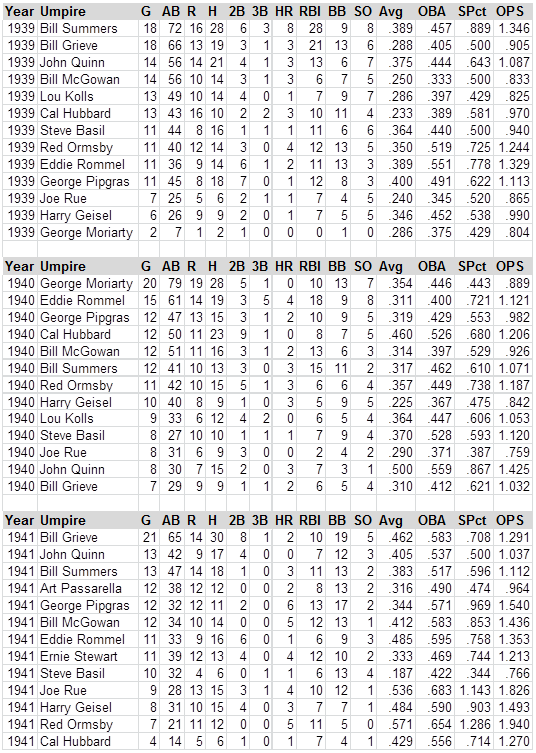
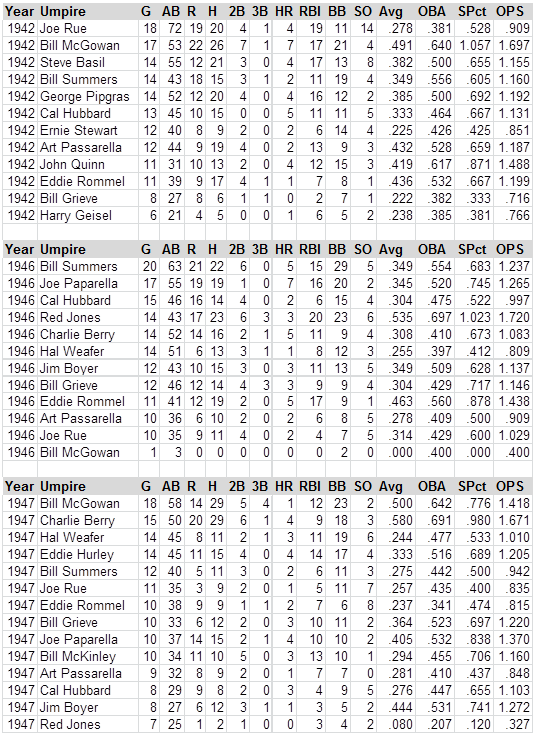
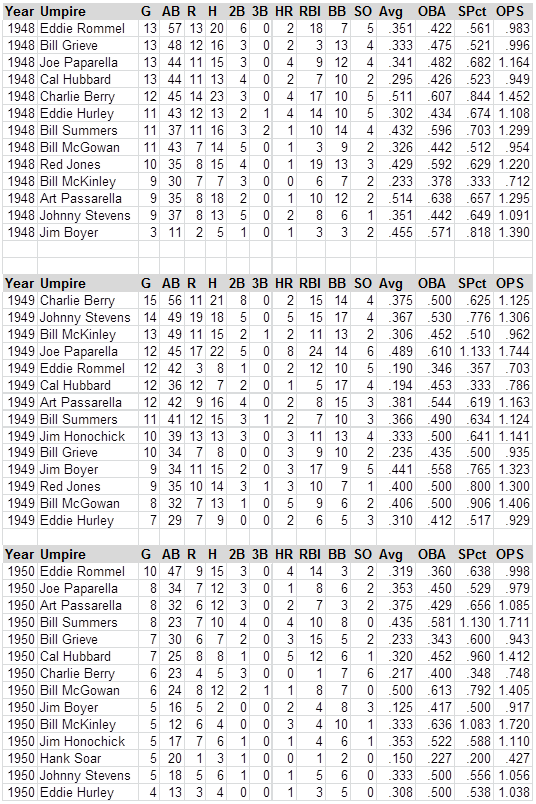
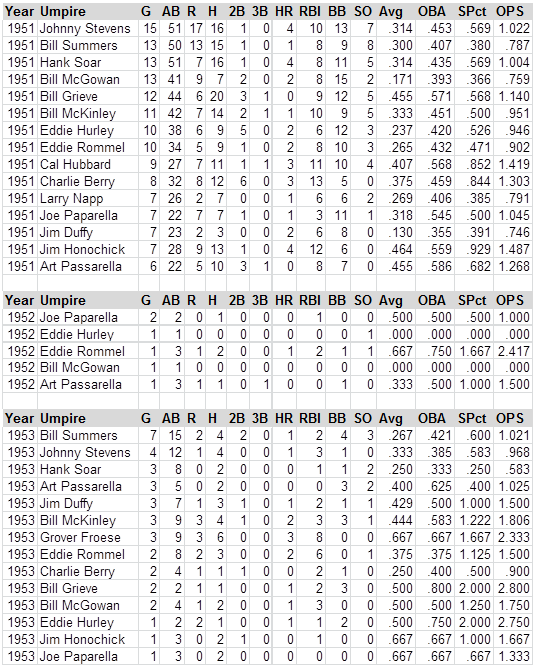
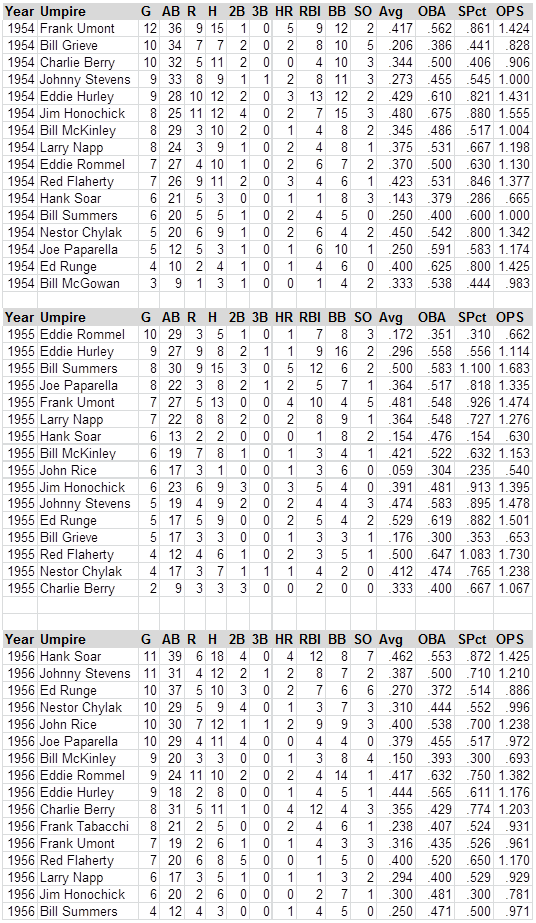
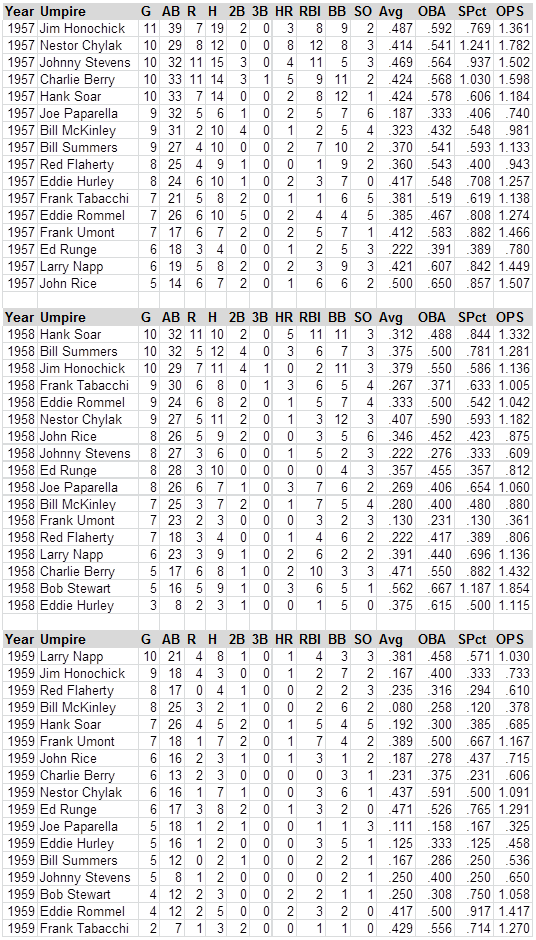
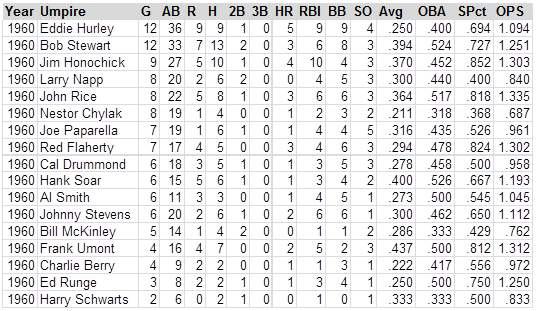
And this chart summarizes what Williams did with each umpire over the course of his career, all umpires given with whom he was paired in twenty or more games:
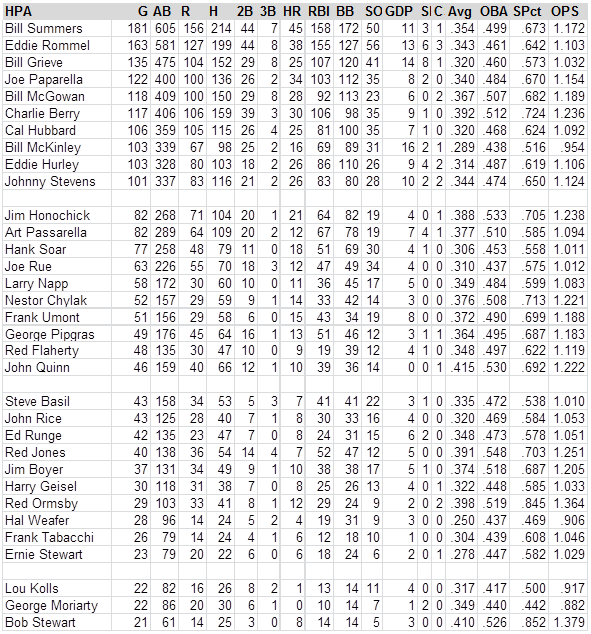
Williams hit .398 with an .845 slugging percentage with Red Ormbsby (29 games), hit only .250 with a .469 slugging percentage with Hal Weafer (28 games)—but his strikeout/walk data, which is what the umpire actually controls, was better with Weaver than with Ormsby. What the data shows is that Williams’ greatness as a hitter doesn’t seem to depend on the umpire. No matter who was umpiring, Williams would rake.
While We’re Here
Since I had Ted Williams’ game logs in a spreadsheet, I figured what Williams had hit over each 154-game sequence of his career. It’s a way of creating a couple of thousand Ted Williams seasons. There is, for example, July 22, 1948 to August 5,1948. Ted Williams played in 154 games in those days, and in those 154 games he hit .380 (213 for 561) with 49 doubles, 32 homers, 141 RBI and 138 walks. It is as legitimate a Ted Williams "season" as those which actually appear in the standard record books; it merely isn’t listed because it isn’t a string of games that starts and ends with a season. A few notes:
- Until August 5, 1959, when he was more than 40 years old, Williams never had any 154-game sequence in which his batting average was below .300. In the 154-game sequence ending on May 20, 1951, Williams’ average dropped to an even .300, albeit with 48 homers and 154 RBI. He had six hits in the next two games, however, rallied off the .300 mark, and never dipped below .300 until 1959.
- What I never knew. . .Williams actually hit fine most of 1959. He started the season late because of an injury, was behind the league, and hit only .173 through June 15 (18 for 104). But from June 16 to the end of the season, he hit .323. He was really Ted Williams most of that season—the one season in which he didn’t hit well overall.
- The most runs Williams ever scored in a 154-game sequence was 162, which he did in 154-game sequences ending on June 11 and June 13, 1950
- The most hits Williams ever had in a 154-game sequence was 216, which he had in the games ending on June 24, 1948. Williams never had a 200 hits in a calendar year, but had 411 154-game sequences in which he gathered 200 or more hits.
- Williams never scored less than 100 runs in a 154-game sequence until September 19, 1953. Until the mid-1950s he generally scored 140 runs or more per 154 games. Even after his speed was gone and he had a lot of pinch hitting appearances in the last six or seven years of his career, he frequently scored more than 120 runs in a 154-game sequence, including as many as 133 (August 23, 1955).
- Williams had a period in August, 1947, in which his "running total" of RBI in his last 154 games dipped below 100 and stayed below 100 for about ten games. Other than that one little run, Williams never drove in less than 100 runs in 154 consecutive games until August, 1956.
- The most doubles Williams hit in 154 games was 52 (June 16 and 17, 1949).
- The most triples was 15 (September 14 to 16, 1940)
- The most home runs Williams ever hit in a 154-game sequence was 50. Williams had 50-homer sequences ending September 15, 16 and 17, 1950 and May 25, 1951. He also had 48-homer sequences ending in mid-season, 1955.
- The most RBI Williams had in a 154-game sequence was 169. Williams had 169 RBI in 154-game sequences ending June 11, 14 and 15, 1950.
- The most walks Williams drew in a 154-game sequence was 180. Williams had 180 walks in 154 games ending August 19, 1955.
- Williams’ highest batting average in a 154-game sequence was .412, sequence ending April 18, 1942. His highest on base percentage, .556, was also recorded on that date, and his highest slugging percentage, .747, was recorded two days earlier (sequence of games ending April 16, 1942.) Williams never hit .400 in a 154-game sequence ending later than April 24, 1942.